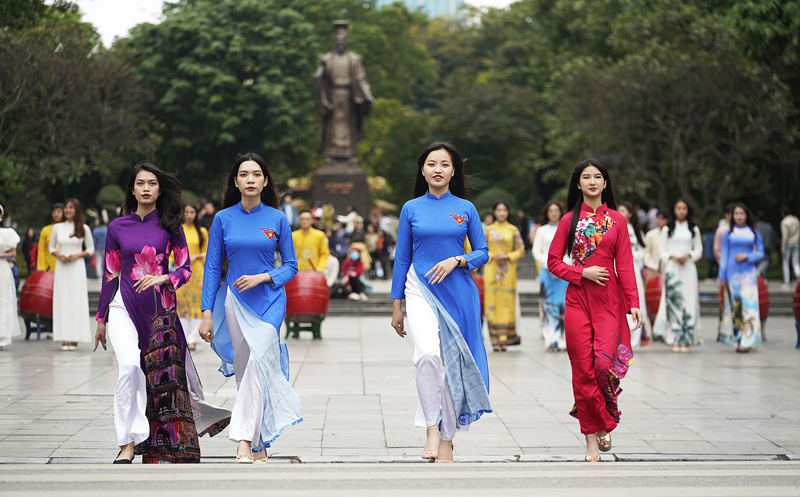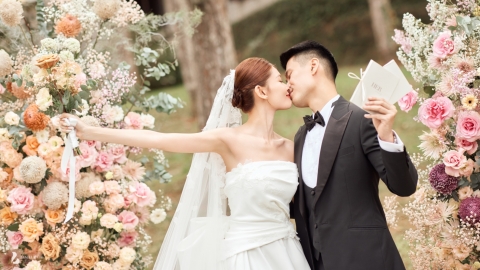Already a "cultural ambassador", why also a "tourism ambassador"?
Surely there is no need for many words to praise the beauty of the Ao Dai because this costume has had a long process of hundreds of years to affirm the irreplaceable position of the Ao Dai in the culture and life of the Vietnamese people. Although there is no official document to recognize it, the Ao Dai is considered as the traditional costume representing the beauty of Vietnam, there are even many calls to honor the Ao Dai to become the "national costume".

The 2022 Hanoi Tourism Ao Dai Festival, which took place in early December, can be considered a memorable step on the path to identifying this traditional costume as a "tourism ambassador".
Ao dai appears more and more widely in daily life as a uniform for students every day going to school, a uniform in the workplace (for many industries such as aviation, education, banking...) and is also a proud choice in solemn events such as weddings, holidays, diplomatic, cultural, entertainment events... domestically and internationally. Ao dai is an endless source of creative inspiration for artists and many world-famous fashion brands such as Reem Acra, Blumarine, Paul Smith, VFiles, Stine Goya... have introduced collections inspired by ao dai. It can be seen that ao dai has truly contributed to introducing Vietnamese culture to the world, becoming a symbol associated with the beauty of Vietnamese women.
So why is the Ao Dai still a “tourism ambassador”? Don’t be quick to think that it’s just a useless drawing or decoration. There are many countries that have succeeded in making traditional costumes an ambassador to promote and advertise tourism. If we take a closer look at Asian countries, it’s easy to see that many tourists (including Vietnamese tourists) cannot ignore this experience, such as wearing hanbok when visiting Korean palaces and ancient villages, wearing kimono in Japan… even wearing Sarong (Thailand) or Longyi (Myanmar) is a mandatory requirement when entering temples if the tourists’ clothing is not modest.
A trip to these countries without taking a few photos in traditional costumes seems… incomplete. Around the world, there are many carnivals (where you can see all kinds of traditional costumes) that are considered “dream experiences” for travel enthusiasts and of course no one “dislikes” the rare opportunity to wear those special costumes.

Ao dai plays an important role in the culture and life of Vietnamese people.
Moreover, in the era of cultural integration, we can easily see traditional costumes of another country on the streets of Vietnam at cosplay festivals, cultural exchange festivals or simply wearing them to take pictures and share on social networks... Just a few simple examples like these are probably enough for everyone to realize the value of traditional costumes in relation to tourism development and the need to designate ambassadors for tourism, not just a meaningless drawing.
What to expect from an “ambassador”?
Back to the Hanoi Tourism Ao Dai Festival 2022 which just ended a few days ago. This is not the first Ao Dai festival held in the country, but there have been hundreds of large and small festivals held (some even held periodically for many years) in all regions, but no festival has really emphasized Ao Dai as a tourism ambassador, most of them just stop at the role of tourism product/experience.
Perhaps thanks to the change in approach, taking place in just 3 short days, the 2022 Hanoi Tourism Ao Dai Festival with many activities such as the performance of Ao Dai from the three regions of North - Central - South, parade and Ao Dai ensemble, space for displaying Ao Dai history and exhibition, Ao Dai design contest... has attracted more than 30,000 domestic and international tourists to attend. This result initially affirms the strong appeal of Ao Dai because the Festival was held in the context of tourism not yet recovering after the Covid-19 pandemic, international tourists returned in small numbers and the Festival was organized hastily, not promoted early enough for tourists to plan to participate.
In fact, the travel experiences with traditional costumes in the above countries can be found similar to the Ao Dai in Vietnam, such as free tickets for people wearing Ao Dai to visit the relics in Hue, the 24-hour Ao Dai tailoring service is very suitable for tourists, or the Ao Dai Museum for those who love to learn more... However, the "touch points" of these experiences with tourism are still vague, even though they exist, they do not really bring tourists the feeling of "not being missed", only stopping at the level of attracting attention.

Ao Dai performance on the walking street
The reason may come from the media method that only focuses on the short launch period, or the media is seasonal (only focuses on organizing related festivals/events), lacking in sustainability so it is easily forgotten. The services have not yet created connections to build a consistent system that is creative and develops together. The festivals that are organized also need to aim for a more luxurious and unique quality, emphasizing the "festival" element with a more modern feel so that visitors turn their interest into action, enthusiastically looking forward to participating in the Ao Dai festivals.
Meanwhile, through hundreds of years of history with many ups and downs, the ao dai itself is not only a beautiful outfit but also contains within those two graceful flaps stories that captivate and thrill people, which can be used as materials to build many unique cultural tourism products, giving visitors the opportunity to explore and immerse themselves in Vietnamese culture. Furthermore, although it is a traditional costume, the ao dai has a design that suits modern aesthetics and is easy to apply in all life activities.
The difference between Eastern and Western culture is also an added advantage for the ao dai in its role as an "ambassador" to not only promote national tourism, introduce Vietnamese culture, attract tourists, but also be able to transform traditional culture into a brand, with the aim of creating added value, and enhancing the national image through the application of traditional cultural content to lifestyle, industry and globalization.



































